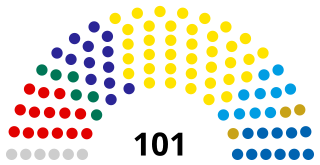
The Singing Revolution was a series of events from 1987 to 1991 that led to the restoration of independence of the three Soviet-occupied Baltic countries of Estonia, Latvia, and Lithuania at the end of the Cold War. The term was coined by an Estonian activist and artist, Heinz Valk, in an article published a week after the 10–11 June 1988 spontaneous mass evening singing demonstrations at the Tallinn Song Festival Grounds.

The Riigikogu is the unicameral parliament of Estonia. In addition to approving legislation, the Parliament appoints high officials, including the prime minister and chief justice of the Supreme Court, and elects the president. Among its other tasks, the Riigikogu also ratifies significant foreign treaties that impose military and proprietary obligations and bring about changes in law, as well as approves the budget presented by the government as law, and monitors the executive power.

The Congress of Estonia was a grassroots parliament elected in February 1990 in then Soviet-occupied Estonia and actively participating in the popular nonviolent resistance to the Soviet rule, which resulted in the restoration of the country's independence from the Soviet Union in August 1991.

Siim Liivik is an Estonian-Finnish professional ice hockey winger who is currently an unrestricted free agent.

The three Baltic states – Estonia, Latvia and Lithuania – were re-occupied in 1944–1945 by the Soviet Union (USSR) following the German occupation. The Baltic states regained independence in 1990–1991.
Parliamentary elections were held in Estonia on 14 and 15 July 1940 alongside simultaneous elections in Latvia and Lithuania. The elections followed the Soviet occupation of the three countries. As was the case in Latvia and Lithuania, the elections in Estonia were blatantly rigged. They were also unconstitutional, since only seats for the lower chamber of the Riigikogu, the Chamber of Deputies, were contested; the upper chamber, the National Council, had been dissolved and was never reconvened. According to August Rei, one of independent Estonia's last envoys to Moscow, under the Estonian constitution, the Chamber of Deputies had "no legislative power" apart from the National Council.
Elections to the Supreme Soviet of the Estonian SSR were held on 16 February 1947. They were the first elections since the Estonian SSR was declared on 21 July 1940 and the first after World War II.
Elections to the Supreme Soviet of the Estonian SSR were held on 25 February 1951. The Bloc of Communists and Non-Party Candidates was the only party able to contest the elections, and won all 115 seats. Elected members included Joseph Stalin, Vyacheslav Molotov, Georgi Malenkov and Panteleimon Ponomarenko.
Elections to the Supreme Soviet of the Estonian SSR were held on 27 February 1955. The Bloc of Communists and Non-Party Candidates was the only party able to contest the elections, and won all 125 seats.
Elections to the Supreme Soviet of the Estonian SSR were held on 15 March 1959. The Bloc of Communists and Non-Party Candidates was the only party able to contest the elections, and won all 125 seats.
Elections to the Supreme Soviet of the Estonian SSR were held on 17 March 1963. The Bloc of Communists and Non-Party Candidates was the only party able to contest the elections, and won all 178 seats.
Elections to the Supreme Soviet of the Estonian SSR were held on 19 March 1967. The Bloc of Communists and Non-Party Candidates was the only party able to contest the elections and won all 178 seats.
Elections to the Supreme Soviet of the Estonian SSR were held on 13 June 1971. The Bloc of Communists and Non-Party Candidates was the only party able to contest the elections, and won all 183 seats.
Elections to the Supreme Soviet of the Estonian SSR were held on 15 June 1975. The Bloc of Communists and Non-Party Candidates was the only party able to contest the elections, and won all 200 seats.
Elections to the Supreme Soviet of the Estonian SSR were held on 24 February 1980. The Bloc of Communists and Non-Party Candidates was the only party able to contest the elections, and won all 285 seats.

The Supreme Soviet of the Estonian SSR was the formal rubber stamp legislative body of the Estonian SSR without any substantive meaning, which was formally elected in general elections, but whose members were essentially appointed by the leadership of the Communist Party. Before 1988, the Supreme Soviet had no meaningful political role. After its first democratic elections on 18 March 1990, the institution was renamed the Supreme Council of the Republic of Estonia on 8 May 1990.
This article lists events that occurred during 1990 in Estonia.

August Liivik was an Estonian sport shooter.







